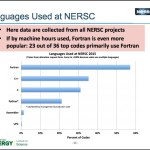In this TACC podcast, Cosmos code developer Chris Fragile joins host Jorge Salazar for a discussion on how researchers are using supercomputers to simulate the inner workings of Black holes. “For this simulation, the manycore architecture of KNL presents new challenges for researchers trying to get the best compute performance. This is a computer chip that has lots of cores compared to some of the other chips one might have interacted with on other systems,” McDougall explained. “More attention needs to be paid to the design of software to run effectively on those types of chips.”
Video: Intel Xeon Phi (KNL) Processor Overview
Adrian Jackson from EPCC at the University of Edinburgh presented this tutorial to ARCHER users. “We have been working for a number of years on porting computational simulation applications to the KNC, with varying successes. We were keen to test this new processor with its promise of 3x serial performance compared to the KNC and 5x memory bandwidth over normal processors (using the high-bandwidth, MCDRAM, memory attached to the chip).”
Changes Afoot from the HPC Crystal Ball
In this special guest feature from Scientific Computing World, Andrew Jones from NAG looks ahead at what 2016 has in store for HPC and finds people, not technology, to be the most important issue. “A disconcertingly large proportion of the software used in computational science and engineering today was written for friendlier and less complex technology. An explosion of attention is needed to drag software into a state where it can effectively deliver science using future HPC platforms.”
Video: Enabling Application Portability across HPC Platforms
“In this presentation, we will discuss several important goals and requirements of portable standards in the context of OpenMP. We will also encourage audience participation as we discuss and formulate the current state-of-the-art in this area and our hopes and goals for the future. We will start by describing the current and next generation architectures at NERSC and OLCF and explain how the differences require different general programming paradigms to facilitate high-performance implementations.”
Video: Using OpenMP at NERSC
“This presentation will describe how OpenMP is used at NERSC. NERSC is the primary supercomputing facility for Office of Science in the US Depart of Energy (DOE). Our next production system will be an Intel Xeon Phi Knights Landing (KNL) system, with 60+ cores per node and 4 hardware threads per core. The recommended programming model is hybrid MPI/OpenMP, which also promotes portability across different system architectures.”








